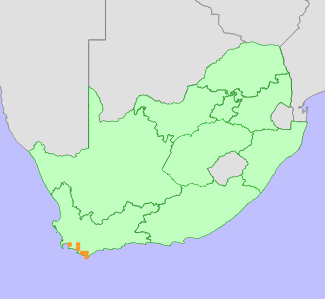The overall population size of this species is unknown, but hundreds of plants have been observed in collection sites and it is considered to be locally common. This resprouting species is thought to be resilient to intensive harvesting over the short-term. Over a number of years, the species can even tolerate 100% harvesting of its stems (Privett et al. 2014), and anecdotal evidence suggests that many local harvesters believe that, effectively, this species cannot be overharvested (Bek and O'Grady 2018). Harvesting at 100% intensity over a time period of greater than five years, though, is not sustainable (Privett et al. 2014), and a number of factors make this scenario a real possibility. Firstly, this species does not reproduce well from seed, and thus it is almost exclusively harvested from wild plants; secondly, for some contractors, the ability to harvest Silver Brunia is critical to offsetting industry costs, so high demand is likely for the foreseeable future; finally, there is evidence that poaching of Silver Brunia is ongoing, negating sustainable harvesting efforts by landowners (Bek and O'Grady 2018). In addition to this, poaching activity is driving legal harvest of Silver Brunia at a younger age than would usually be practised (Bek and O'Grady 2018).
As this species is currently one of the most sought after wild fynbos plants, harvesting is placing pressure on the wild population (Privett et al. 2020), and the population is declining. Furthermore, an estimated 27% of the population is suspected to have decline as a result of the combined impacts of overharvesting and loss of habitat to crop cultivation and invasive alien plants over the past 150 years. There is ongoing low levels of habitat loss to cultivation.
|
Bek, D. and O'Grady, K. 2018. The scale, structure and sustainability of the wild fynbos harvesting supply chain in the Cape Floral Kingdom. Cape Town, South Africa.
Goldblatt, P. and Manning, J.C. 2000. Cape Plants: A conspectus of the Cape Flora of South Africa. Strelitzia 9. National Botanical Institute, Cape Town.
Manning, J.C. and Goldblatt, P. 2012. Plants of the Greater Cape Floristic Region 1: The Core Cape Flora. Strelitzia 29. South African National Biodiversity Institute, Pretoria.
Privett, S., Bailey, R., Raimondo, D., Kirkwood, D. and Euston-Brown, D. 2005. A vulnerability index for rare and harvested plant species on the Agulhas Plain. Flower Valley Conservation Trust.
Privett, S., Bek, D., Bailey, R., Binns, T., Raimondo, D., Kirkwood, D. and Euston-Brown, D. 2020. Conservation in the context of wildflower harvesting: the development and implementation of a Vulnerability Index on the Agulhas Plain of South Africa. Journal of Environmental Planning and Management 63(10):1738–1757.
Privett, S.D.J., Krug, R.M., Forbes, G. and Gaertner, M. 2014. Wild Flower Harvesting on the Agulhas Plain, South Africa: Impact of Harvesting Intensity under a Simulated Commercial Harvesting Regime for Two Re-Seeding and Two Re-Sprouting Fynbos Species. South African Journal of Botany 94 270-275.
Raimondo, D., von Staden, L., Foden, W., Victor, J.E., Helme, N.A., Turner, R.C., Kamundi, D.A. and Manyama, P.A. 2009. Red List of South African Plants. Strelitzia 25. South African National Biodiversity Institute, Pretoria.
|
 Comment on this assessment
Comment on this assessment


